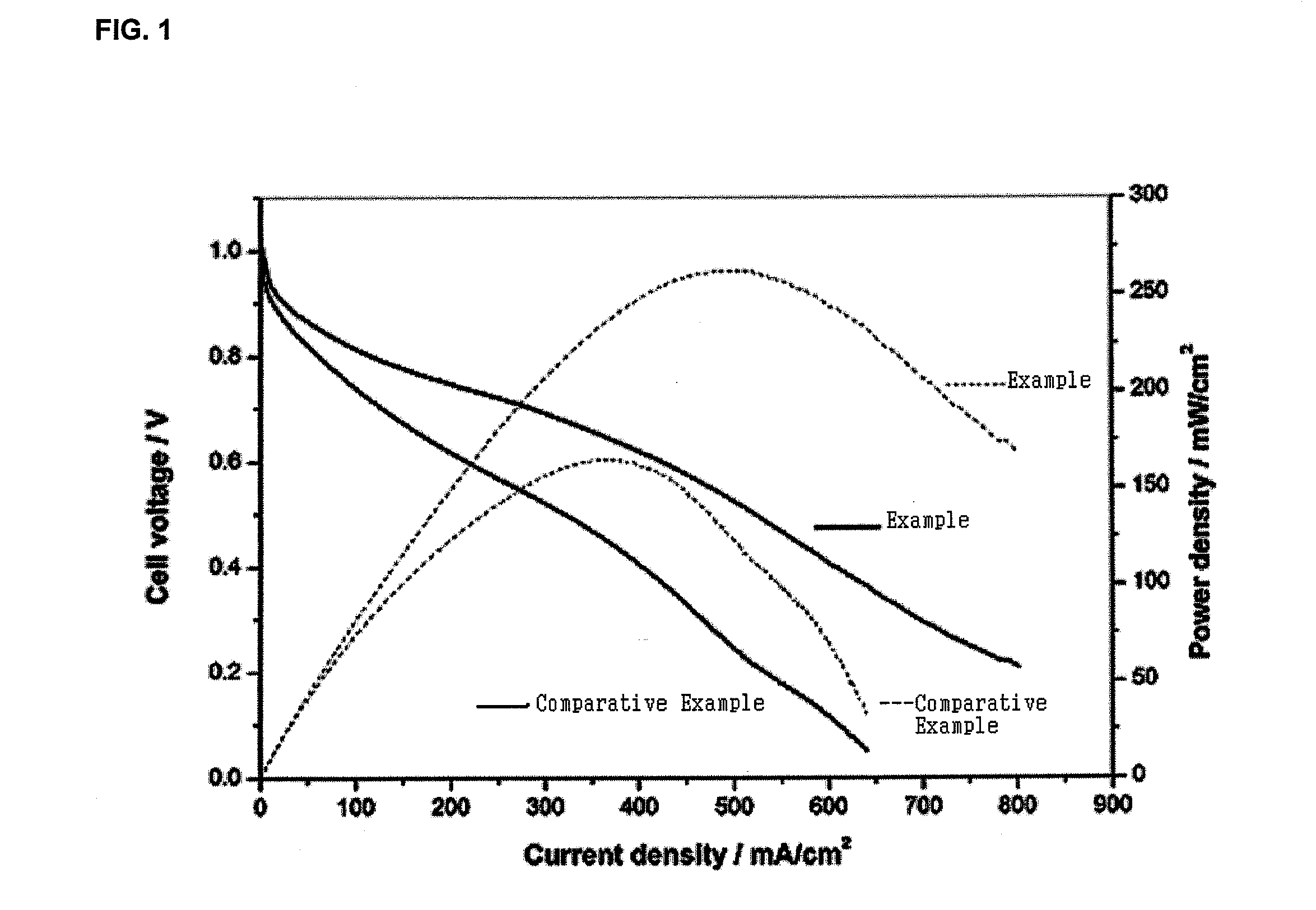Anion binder for solid alkaline fuel cell, method of preparing the same and membrane-electrode assembly
a solid alkaline fuel cell and anion binder technology, applied in the direction of cell components, final product manufacturing, sustainable manufacturing/processing, etc., can solve the problems of non-crosslinked polymers in terms of durability and problems in the production of electrode slurry, and achieve excellent hydroxide ion conductivity, enhance durability, and suppress deterioration
- Summary
- Abstract
- Description
- Claims
- Application Information
AI Technical Summary
Benefits of technology
Problems solved by technology
Method used
Image
Examples
example 1
Preparation of Hydroxide Ion Conducting Binder
[0034](vinylbenzyl)trimethylammonium chloride as a hydroxide ion conducting monomer, N,N′-bisacryloylpiperazine as a crosslinking agent, and deionized water were mixed together by stirring at a weight ratio of 61.5:15.4:23.1, and 100 parts by weight of the mixed solution was mixed with 1 part by weight of a dilution of 2-hydroxy-2-methyl-1-phenyl-1-one (10 wt %) as a photoinitiator in methanol.
[0035]Afterwards, the solution was interposed between polyethylene terephthalate films to avoid the permeation of oxygen, which interferes with polymerization, and then irradiated with ultraviolet (UV) light having an energy of 30 to 150 mJ / cm2.
[0036]Crosslinked polymerized resin was pulverized to a size of 50 μm by a grinding pulverizer, and 5% by weight of the powder obtained in the primary pulverization was dispersed in a mixed solution of 1-propanol and water at a weight ratio of 9:1 and pulverized by a wet pulverizer until the powder has a siz...
example 2
Preparation of Membrane-Electrode Assembly
Preparation of Anion-Exchange Polymer Electrolyte Membrane
[0037](vinylbenzyl)trimethylammonium chloride, N,N′-bisacryloylpiperazine, and deionized water were mixed together by stirring at a weight ratio of 61.5:15.4:23.1, and 100 parts by weight of the mixed solution was mixed with 1 part by weight of a dilution of 2-hydroxy-2-methyl-1-phenyl-1-one (Darocur 1173; 10 wt %) as a photoinitiator in methanol.
[0038]Afterwards, a polyolefin-based porous polymer support having a film thickness of 25 μm, an average pore size of 0.07 μm, and a pore distribution of 45% was impregnated with the solution so that a monomer solution soaks into the support. Subsequently, an electrolyte-impregnated membrane was interposed between polyethylene terephthalate (PET) films and then irradiated with ultraviolet (UV) light having an energy of 30 to 150 mJ / cm2.
[0039]After the crosslinking step, the PET films were removed, by-products on the membrane surface were remo...
PUM
| Property | Measurement | Unit |
|---|---|---|
| Percent by mass | aaaaa | aaaaa |
| Size | aaaaa | aaaaa |
| Size | aaaaa | aaaaa |
Abstract
Description
Claims
Application Information
 Login to View More
Login to View More - R&D
- Intellectual Property
- Life Sciences
- Materials
- Tech Scout
- Unparalleled Data Quality
- Higher Quality Content
- 60% Fewer Hallucinations
Browse by: Latest US Patents, China's latest patents, Technical Efficacy Thesaurus, Application Domain, Technology Topic, Popular Technical Reports.
© 2025 PatSnap. All rights reserved.Legal|Privacy policy|Modern Slavery Act Transparency Statement|Sitemap|About US| Contact US: help@patsnap.com



